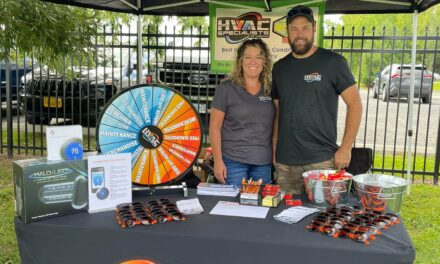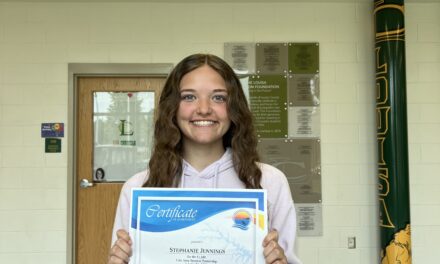
The Lake Anna Civic Association (LACA) had a terrific turnout for the homeowner groups’ annual meeting held July 29 at Dominion Energy’s North Anna Visitor’s Center.
At the meeting there was a great presentation from the Virginia Department of Environmental Quality on the state of the $3.5MM HAB study authorized by the state as well as a debrief from our various committee chairs on LACA’s activities this past year. The meeting is available to view at lakeannavirginia.org.
During the meeting, LACA presented Chris Lee from Louisa County with the Jack Bertron Award. Lee has tirelessly dedicated his time to the community in helping LACA with the yellow and black emergency 911 signs around the lake. These signs save pre-cious minutes in 911 response times for emergencies on Lake Anna.
LACA’s newly formed President’s Council had our first meeting on April 21st with 37 attendees. The PC is open to the President (or a member of the board) of the various HOA/POAs around the lake. For those communities that do not have a formal board, LACA asked for a community liaison to attend on behalf of their community.
There are approximately 107 HOA/POAs and 122 subdivisions at Lake Anna. LACA hopes to provide a forum so that the various communities have the opportunity to share ideas. If your community is not represented, please reach out to the PC Commit-tee Chair: rick.nehrboss@lakeannavirginia.org The next meeting is tentatively sched-uled for September 22.
LACA conducted a biennial survey of membership this summer. There were 573 responses, up 15% from 2021. LACA uses this survey to understand the views of membership so that the group can effectively communicate the views of members to elected officials and others around Lake Anna. The LACA Action Plans are based on the survey information.
Homeowners at Smith Mountain Lake are suffering with their first HAB recreational advisory this year. LACA members had a productive Zoom meeting with Water Quality Committee Chair, Harry Looney and Smith Mountain Lake Association’s Water Quality Chair, Keri Green this summer. The goal of the meeting was to work cooperatively with a goal of eliminating HABs on both lakes.
LACA’s Water Quality Committee is executing several projects to collect data so that the group can assess the lake and the streams in the watershed for potential water quality issues. Committee members and volunteers completed a third sampling with the DEQ on Tuesday, August 15th.
“The results from the August sampling should be available on our website by mid-September after we receive the test results from the state lab in Richmond and we will conduct one final sampling session with DEQ in October,” noted Looney who oversaw much of the effort.
Looney told Life & Times that LACA will also conduct their second macroinvertebrate sampling session of 2023 in October.
“We partner with Louisa County High
School, the Lake Anna State Park, and the Alliance for the Chesapeake Bay to sample three stream sites for the small ‘critters’ that live on rocks and leaves at the bottom of the streams. These ‘critters’ provide a good indication of the health of the water and ecosystem in the area surrounding the collection site.”
Looney also noted LACA will also be completing a cyanobacteria mitigation testing in October. The group will review the data collected this year and provide a final report to members and donors to LACA’s Kick the HAB AGAIN! campaign by the end of January 2024. LACA updates their website regularly so keep an eye on the Water Quality Committee web page (https://lakeannavirginia.org/Water-Quality) for updates.
LACA’s Water Quality program is made possible through grants from Louisa and Spotsylvania counties, Virginia DEQ, member dues, donations, fundraising events, and more than 45 volunteers that donate their time and energy to these efforts.
“Total volunteer hours in 2022 was 2,374 hours and it looks like we will exceed that number this year. Please contact Harry Looney, the LACA Water Quality Program Manager, at harry.looney@lakeannavirginia.org if you want to get involved in our volunteer efforts or if you want to get more information on our water quality program,” LACA President Greg Baker told L&T.
For the past several months, LACA’s Environmental Preservation Committee has been focused on planting native aquatic vegetation along and in the Lake shoreline. With the help of volunteers and with funding from a $10,000 DuPont grant, they will have planted approximately 2000 native plants by the end of August. In addition, they planted approximately 250 aquatic plants in existing or newly installed floating wetlands.
LACA volunteers are careful to use plants that are native to the Lake Anna area. As part of that effort, they recently toured the private side with a noted botanist who has worked for years with the Virginia Department of Conservation and Recreation. LACA will be hosting a similar tour of the public side in September. One goal of these tours is to identify native and invasive plants on the lake.
LACA received a $10,000 grant from Dominion Energy to continue and expand this work. In addition to continued lake shoreline planting, and the group is identifying landowners farther up the watershed who will allow them to plant riparian buffers. Virginia Department of Forestry, Natural Resources Conservation Service and other partners like Friends of the Rappahannock are helping LACA to identify these landowners.
“By planting buffers farther up the watershed, we hope to reduce the amount of nutrients entering the lake, rather than addressing them once they are here,” noted Looney.
LACA has set a fundraising goal of $50,000 for “Kick the HAB…AGAIN! To date, the community has contributed just over $30,000. To continue the HAB research and volunteer programs LACA needs to surpass the original goal. You can make a tax-deductible contribution to LACA at lakeannavirginia.org/donate




















